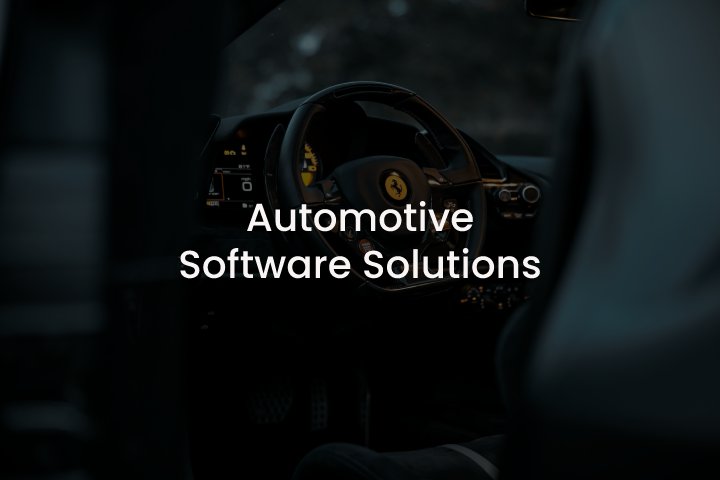Regulatory Decision-Making Solution for a Prominent Healthcare Provider
Navigating complex regulations with the decision-making solution in the healthcare industry is an important step for staying up-to-date and delivering …
 20 | 02 | 2023
20 | 02 | 2023 The automotive industry is evolving at breakneck speed. The auto industry is now a software industry with a $2.9 trillion-dollar economy, where every player uses software to build or improve vehicles and generate data, they can use in post-sale operations. From design to manufacturing, distribution, and support of vehicles, the auto industry has become more open than ever. It is no longer a world controlled by automakers; it is.
Custom software development is a critical component of the automotive supply chain and has been for decades. But even as technological advancements have taken hold in other aspects of car manufacturing and design, custom software remains an integral part of what makes cars and trucks move down the assembly line.
Automakers are increasingly seeking ways to innovate through increased software adoption. To reduce new model development time frames and improve product quality, original equipment manufacturers (OEM) are turning to custom software design. From top-quality products to personalized services and support, successful companies listen to their customers.
Software design is playing a more significant role in the industry, and the growth of software development has been phenomenal. There are different types and categories of software design that are becoming increasingly important to automakers. The process evolves quickly, sometimes changing with each new vehicle model and technology.
The automotive supply chain is a highly complex, interconnected system that drives technology innovation and business success. In this article, we will look at the key technologies for automating and streamlining your processes, but first, let’s look at what makes up an automotive supply chain.
There are a variety of software programs to help automotive component suppliers and car makers optimize their supply chains. These include BOM management systems, EDI, RFQ management, Quote-to-Order systems, BOM synchronization software, and more.
Automotive OEMs have been slow to adapt to these changes, but third-party developers are stepping in to fill the gap by developing apps and services that make it easier for consumers to manage their vehicles. This has created an opportunity for software developers who can develop apps that meet these needs.
However, as with any innovative technology, some challenges must be overcome before it becomes more widely adopted. There are also opportunities for developers who can help overcome these challenges.
Since the automotive industry has been shifting towards automation and technology, manufacturers have been investing more in R&D to develop modern technologies such as artificial intelligence (AI), machine learning (ML), and blockchain. These technologies can help improve efficiency by streamlining processes and dropping human error. With the adoption of technologies, there are certain pros and arising that need to be considered to receive the desired business outcomes.

Autonomous driving is the technology that enables a vehicle to drive itself without human input. The first and most obvious benefit of autonomous driving is safety. Traffic accidents are often caused by human error, and autonomous cars can avoid these accidents.
Autonomous cars also have the potential to be more fuel efficient than conventional vehicles. A self-driving car can drive more smoothly than a human driver, which reduces friction and improves fuel consumption.
The biggest obstacle to the widespread adoption of autonomous vehicles is cost. Autonomous vehicles are more expensive than standard models because they require expensive sensor equipment and software programming. However, this cost should decrease over time as the technology becomes more widespread.
The biggest downside of autonomous driving is its effect on employment in the transportation industry. Driverless cars will eliminate millions of jobs for truckers, taxi drivers, bus drivers, and others who earn their living transporting people or goods from place to place by car or other vehicles.
Successful software products to handle vehicles and ensure their safety require prompt and constant updates. The issue of connectivity is that software can be vulnerable to cyberattacks. This is a critical issue not only for the safety of the vehicle and the driver but also mitigates risks for business owners. The disadvantages of poor connectivity are financial and legal liabilities, and tarnished reputation, to name a few.
To prevent the outcomes, setting reliable connectivity and restricted access are imperative. Adoption of technologies that ensure secure accessibility and management of the data shall be the top priority for business owners.
Based on the McKinsey research on Automotive software and electronics 2030, validation and verification will have taken up to 29% of the entire automotive software market by 2030. The number of tools for improving such a crucial stage of the software delivery process is growing to promote the trend of quicker debugging and continuous integration of newer versions of the software or its constituents.
With the automotive industry constantly evolving, it is no surprise that the software skills and toolsets used in the industry are also changing. The automotive industry is growing rapidly and there is a huge demand for software developers. Most of these jobs require candidates with deep technical expertise and experience in one or more specific technologies. This means that automotive companies need to invest more time, energy, and money into training their employees to become experts in their fields.
The automotive industry is among the largest employers in all of Europe, totaling almost 14 million employees (about twice the population of Arizona) which amounts to around 7% of the entire EU employment statistics. With such a large workforce, it is no easy feat to find highly qualified individuals who are willing to relocate or work remotely — especially when they are already employed elsewhere. Talent hunting is envisaged to grow in the years to come as the industry’s potential growth is at its finest.
From connected vehicles to autonomous cars and ride-sharing services, the software is driving the industry forward at a rapid pace. But what does it take to stay competitive?
The answer is simple: Acquire the right talent with the right skill set, follow the latest trends and technological advancements, and invest in R&D and marketing. All these steps will help business owners not only withstand the highly competitive market thus far but also become leaders and examples for others to follow.
The Agiliway software development team developed solutions for the automotive industry and is willing to take up your project and make it different. Contact our experts and learn how we can help you with the solution that will transform the industry.
READ ALSO: HOW TO INTEGRATE YOUR NEW SOFTWARE DEVELOPMENT SERVICE PROVIDER INTO YOUR ORGANIZATION
Navigating complex regulations with the decision-making solution in the healthcare industry is an important step for staying up-to-date and delivering …
Welcome back to the tech news rubric. This month’s tech news is bursting at the seams! We’ll explore the latest …
The travel industry has undergone a massive transformation in recent years, with travelers increasingly booking vacations and making travel arrangements …